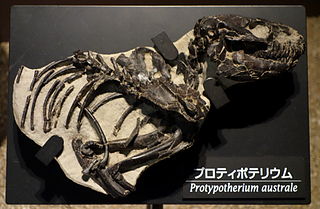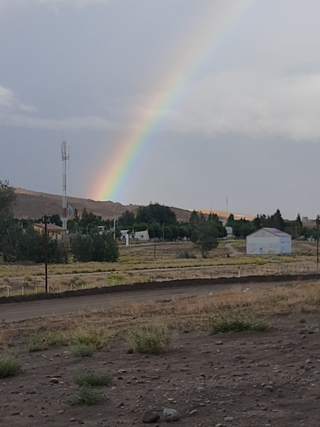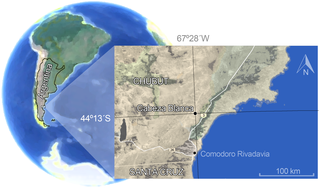
Killikaike is an extinct genus of New World monkey. The genus includes one species, Killikaike blakei, that lived in Argentina during the Early Miocene.

Protypotherium is an extinct genus of notoungulate mammals native to South America during the Oligocene and Miocene epochs. A number of closely related animals date back further, to the Eocene. Fossils of Protypotherium have been found in the Deseadan Fray Bentos Formation of Uruguay, Muyu Huasi and Nazareno Formations of Bolivia, Cura-Mallín and Río Frías Formations of Chile, and Santa Cruz, Salicas, Ituzaingó, Aisol, Cerro Azul, Cerro Bandera, Cerro Boleadoras, Chichinales, Sarmiento and Collón Curá Formations of Argentina.

Cramauchenia is an extinct genus of litoptern South American ungulate. Cramauchenia was named by Florentino Ameghino. The name has no literal translation. Instead, it is an anagram of the name of a related genus Macrauchenia. This genus was initially discovered in the Sarmiento Formation in the Chubut Province, in Argentina, and later it was found in the Chichinales Formation in the Río Negro Province and the Cerro Bandera Formation in Neuquén, also in Argentina, in sediments assigned to the SALMA Colhuehuapian, as well as the Agua de la Piedra Formation in Mendoza, in sediments dated to the Deseadan. In 1981 Soria made C. insolita a junior synonym of C. normalis. A specimen of C. normalis was described in 2010 from Cabeza Blanca in the Sarmiento Formation, in sediments assigned to the Deseadan SALMA.
The Hispaniola monkey is an extinct primate that was endemic on the island of Hispaniola, in the present-day Dominican Republic. The species is thought to have gone extinct around the 16th century. The exact timing and cause of the extinction are unclear, but it is likely related to the settlement of Hispaniola by Europeans after 1492.
Stirtonia is an extinct genus of New World monkeys from the Middle Miocene. Its remains have been found at the Konzentrat-Lagerstätte of La Venta in the Honda Group of Colombia. Two species have been described, S. victoriae and the type species S. tatacoensis. Synonyms are Homunculus tatacoensis, described by Ruben Arthur Stirton in 1951 and Kondous laventicus by Setoguchi in 1985. The genus is classified in Alouattini as an ancestor to the modern howler monkeys.
Acrecebus is a prehistoric cebid monkey from the Late Miocene Solimões Formation of Acre State, Brazil and Bolivia. The only species known is A. fraileyi. This genus is closely related to the genus Cebus.
Solimoea acrensis is a prehistoric ateline monkey from the Late Miocene Solimões Formation of Brazil. It is the only known species of the genus Solimoea.

Cebupithecia is an extinct genus of New World monkeys from the Middle Miocene. Its remains have been found at the Konzentrat-Lagerstätte of La Venta in the Honda Group of Colombia. The type species is C. sarmientoi.
Lagonimico is an extinct genus of New World monkeys from the Middle Miocene. Its remains have been found at the Konzentrat-Lagerstätte of La Venta in the Honda Group of Colombia. The type species is Lagonimico conclucatus.
Micodon is an extinct genus of New World monkeys from the Middle Miocene. Its remains have been found at the Konzentrat-Lagerstätte of La Venta in the Honda Group of Colombia. The type species is M. kiotensis, a very small monkey among the New World species.
Mohanamico is an extinct genus of New World monkeys from the Middle Miocene. Its remains have been found at the Konzentrat-Lagerstätte of La Venta in the Honda Group of Colombia. The type species is M. hershkovitzi. Due to the relatively few material found of Mohanamico, the placement of the genus is not certain and four possible families have been proposed by different authors, Atelidae, Callitrichidae, Pitheciidae or Aotidae.
Patasola is an extinct genus of New World monkeys from the Middle Miocene. Its remains have been found at the Konzentrat-Lagerstätte of La Venta in the Honda Group of Colombia. The type species is Patasola magdalenae.
Saimiri annectens, originally described as Laventiana annectens and later as Neosaimiri annectens, is an extinct species of New World monkey in the genus Saimiri from the Middle Miocene. Its remains have been found at the Konzentrat-Lagerstätte of La Venta in the Honda Group of Colombia.
Saimiri fieldsi is an extinct species of New World monkey in the genus Saimiri from the Middle Miocene. Its remains have been found at the Konzentrat-Lagerstätte of La Venta in the Honda Group of Colombia.

Hegetotherium is an extinct genus of mammals from the Early to Middle Miocene of South America. Fossils of this genus have been found in the Cerro Bandera, Cerro Boleadoras, Chichinales, Collón Curá, Santa Cruz and Sarmiento Formations of Argentina, the Nazareno Formation of Bolivia, and the Galera and Río Frías Formations of Chile.

The Collón Curá Formation is a Middle Miocene fossiliferous geological formation of the southern Neuquén Basin in northwestern Patagonia and the western Cañadón Asfalto Basin of central Patagonia, Argentina. The formation crops out from the southern Neuquén Province, the western Río Negro Province to the northern Chubut Province.

The Sarmiento Formation, in older literature described as the Casamayor Formation, is a geological formation in Chubut Province, Argentina, in central Patagonia, which spans around 30 million years from the mid-Eocene to the early Miocene. It predominantly consists of pyroclastic deposits, which were deposited in a semi-arid environment. It is divided up into a number of members. The diverse fauna of the Sarmiento Formation, including a variety of birds, crocodilians, turtles and snakes, also includes many mammals such as South American native ungulates as well as armadillos, and caviomorph rodents.

The Santa Cruz Formation is a geological formation in the Magallanes/Austral Basin in southern Patagonia in Argentina and adjacent areas of Chile. It dates to the late Early Miocene epoch, and is contemporaneous with the eponymous Santacrucian age of the SALMA timescale. The Santa Cruz Formation is known for its abundance of vertebrate fossils, including South American native ungulates, as well as rodents, xenarthrans, and metatherians.












